Virtual Learning Environment Impact on Student Learning: A Case
VerifiedAdded on 2023/01/17
|13
|2628
|49
Case Study
AI Summary
This case study investigates the impact of Virtual Learning Environments (VLE) on student learning experiences, focusing on Wales Trinity Saint David London Campus. It aims to determine student performance and frequency in accessing VLE, evaluate the advantages and disadvantages of VLE in the student learning cycle, and recommend improvements for better student-teacher relationships. The research employs a qualitative approach, utilizing questionnaires to gather primary data and analyzing secondary data from journals and articles. Findings suggest that VLE can enhance student performance and efficiency, with many students agreeing that it fosters a positive learning environment. The study concludes that VLE is a valuable tool for education, improving student abilities and capabilities, and recommends further implementation and innovation in online education channels to maximize its benefits.

Digital skill and research methods
1
1
Paraphrase This Document
Need a fresh take? Get an instant paraphrase of this document with our AI Paraphraser
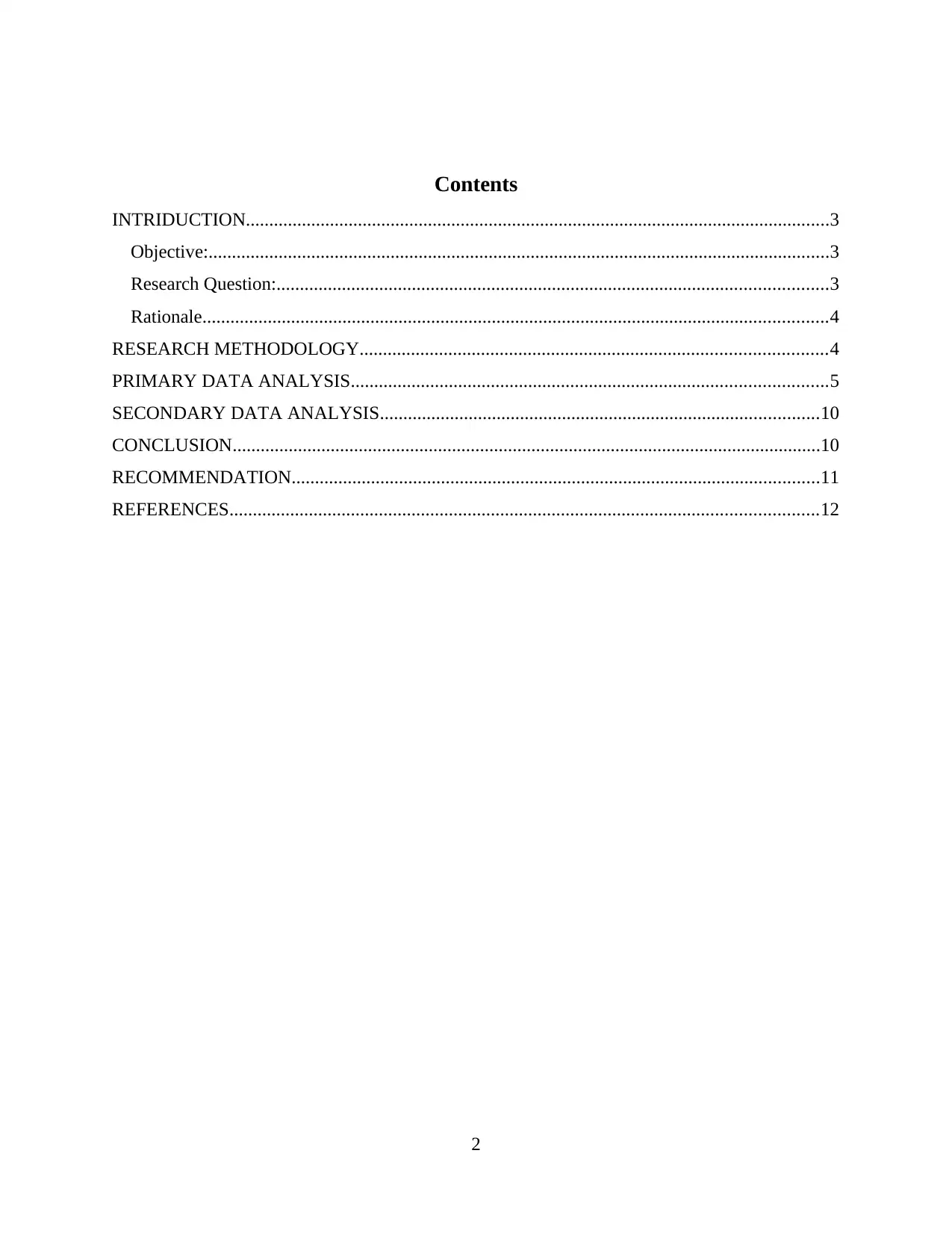
Contents
INTRIDUCTION.............................................................................................................................3
Objective:.....................................................................................................................................3
Research Question:......................................................................................................................3
Rationale......................................................................................................................................4
RESEARCH METHODOLOGY....................................................................................................4
PRIMARY DATA ANALYSIS......................................................................................................5
SECONDARY DATA ANALYSIS..............................................................................................10
CONCLUSION..............................................................................................................................10
RECOMMENDATION.................................................................................................................11
REFERENCES..............................................................................................................................12
2
INTRIDUCTION.............................................................................................................................3
Objective:.....................................................................................................................................3
Research Question:......................................................................................................................3
Rationale......................................................................................................................................4
RESEARCH METHODOLOGY....................................................................................................4
PRIMARY DATA ANALYSIS......................................................................................................5
SECONDARY DATA ANALYSIS..............................................................................................10
CONCLUSION..............................................................................................................................10
RECOMMENDATION.................................................................................................................11
REFERENCES..............................................................................................................................12
2
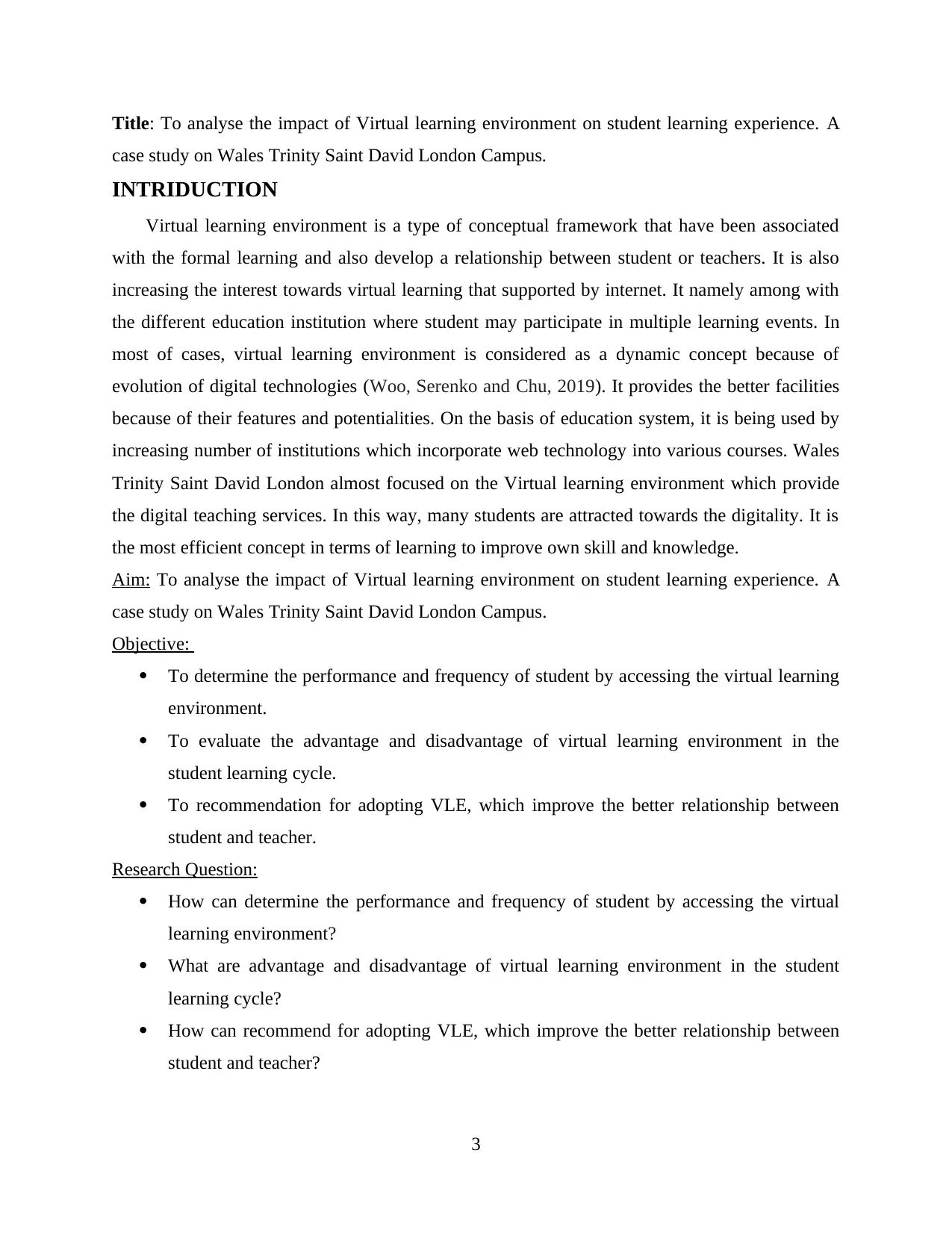
Title: To analyse the impact of Virtual learning environment on student learning experience. A
case study on Wales Trinity Saint David London Campus.
INTRIDUCTION
Virtual learning environment is a type of conceptual framework that have been associated
with the formal learning and also develop a relationship between student or teachers. It is also
increasing the interest towards virtual learning that supported by internet. It namely among with
the different education institution where student may participate in multiple learning events. In
most of cases, virtual learning environment is considered as a dynamic concept because of
evolution of digital technologies (Woo, Serenko and Chu, 2019). It provides the better facilities
because of their features and potentialities. On the basis of education system, it is being used by
increasing number of institutions which incorporate web technology into various courses. Wales
Trinity Saint David London almost focused on the Virtual learning environment which provide
the digital teaching services. In this way, many students are attracted towards the digitality. It is
the most efficient concept in terms of learning to improve own skill and knowledge.
Aim: To analyse the impact of Virtual learning environment on student learning experience. A
case study on Wales Trinity Saint David London Campus.
Objective:
To determine the performance and frequency of student by accessing the virtual learning
environment.
To evaluate the advantage and disadvantage of virtual learning environment in the
student learning cycle.
To recommendation for adopting VLE, which improve the better relationship between
student and teacher.
Research Question:
How can determine the performance and frequency of student by accessing the virtual
learning environment?
What are advantage and disadvantage of virtual learning environment in the student
learning cycle?
How can recommend for adopting VLE, which improve the better relationship between
student and teacher?
3
case study on Wales Trinity Saint David London Campus.
INTRIDUCTION
Virtual learning environment is a type of conceptual framework that have been associated
with the formal learning and also develop a relationship between student or teachers. It is also
increasing the interest towards virtual learning that supported by internet. It namely among with
the different education institution where student may participate in multiple learning events. In
most of cases, virtual learning environment is considered as a dynamic concept because of
evolution of digital technologies (Woo, Serenko and Chu, 2019). It provides the better facilities
because of their features and potentialities. On the basis of education system, it is being used by
increasing number of institutions which incorporate web technology into various courses. Wales
Trinity Saint David London almost focused on the Virtual learning environment which provide
the digital teaching services. In this way, many students are attracted towards the digitality. It is
the most efficient concept in terms of learning to improve own skill and knowledge.
Aim: To analyse the impact of Virtual learning environment on student learning experience. A
case study on Wales Trinity Saint David London Campus.
Objective:
To determine the performance and frequency of student by accessing the virtual learning
environment.
To evaluate the advantage and disadvantage of virtual learning environment in the
student learning cycle.
To recommendation for adopting VLE, which improve the better relationship between
student and teacher.
Research Question:
How can determine the performance and frequency of student by accessing the virtual
learning environment?
What are advantage and disadvantage of virtual learning environment in the student
learning cycle?
How can recommend for adopting VLE, which improve the better relationship between
student and teacher?
3
⊘ This is a preview!⊘
Do you want full access?
Subscribe today to unlock all pages.

Trusted by 1+ million students worldwide

Rationale
The purpose of research is to understand the concept about virtual learning environment
which always applicable used in different institution for purpose of learning. Most of student will
improve their abilities and capabilities for future career enhancement. The rationale of research
project is providing brief idea about the topic and also focused on its articulate concepts. Scholar
will build understanding towards virtual learning environment and share their own opinion that
how it will benefit for student in education level. According to research project, scholar also
identified that Virtual learning environment added more features that directly turn into space
which allow for purpose of promotion. Testing and also supporting in the high planned and
directed manner.
RESEARCH METHODOLOGY
It is defined as an activity that mainly including the finding which can be analysed in
systematic manner (Wijesooriya, Heales and Rohde, 2019). Research methodology is based on
the conceptual framework within research that organise foundation on behalf of evidence.
Research method:
It is a type of process that collect data related the project while representing the range of
element that associated with research study. The research type can be divided into two ways:
Qualitative research and Quantitative research (Huang and et.al., 2019).
Qualitative data collection method is based on the assumptions that considered existing
theories and models which applicable in the information gathering. It will provide brief idea
about the previous existing theories and became easier for researcher to criticise.
Quantitative research method is based on the numerical calculation where it measures
overall mathematic data or information. This type of method will provide the accurate results on
the basis of solution.
Scholar will choose qualitative research method for collecting large volume of
information regarding research topic. It will gather relevant information about project through
questionnaire for identifying the opinion of student within institution.
Research Design:
It is based on the strategy that has to be implemented within research study and how it
can be analysed that understand overall concept of project. Research design can be categorised
into different ways: conclusive and exploratory.
4
The purpose of research is to understand the concept about virtual learning environment
which always applicable used in different institution for purpose of learning. Most of student will
improve their abilities and capabilities for future career enhancement. The rationale of research
project is providing brief idea about the topic and also focused on its articulate concepts. Scholar
will build understanding towards virtual learning environment and share their own opinion that
how it will benefit for student in education level. According to research project, scholar also
identified that Virtual learning environment added more features that directly turn into space
which allow for purpose of promotion. Testing and also supporting in the high planned and
directed manner.
RESEARCH METHODOLOGY
It is defined as an activity that mainly including the finding which can be analysed in
systematic manner (Wijesooriya, Heales and Rohde, 2019). Research methodology is based on
the conceptual framework within research that organise foundation on behalf of evidence.
Research method:
It is a type of process that collect data related the project while representing the range of
element that associated with research study. The research type can be divided into two ways:
Qualitative research and Quantitative research (Huang and et.al., 2019).
Qualitative data collection method is based on the assumptions that considered existing
theories and models which applicable in the information gathering. It will provide brief idea
about the previous existing theories and became easier for researcher to criticise.
Quantitative research method is based on the numerical calculation where it measures
overall mathematic data or information. This type of method will provide the accurate results on
the basis of solution.
Scholar will choose qualitative research method for collecting large volume of
information regarding research topic. It will gather relevant information about project through
questionnaire for identifying the opinion of student within institution.
Research Design:
It is based on the strategy that has to be implemented within research study and how it
can be analysed that understand overall concept of project. Research design can be categorised
into different ways: conclusive and exploratory.
4
Paraphrase This Document
Need a fresh take? Get an instant paraphrase of this document with our AI Paraphraser
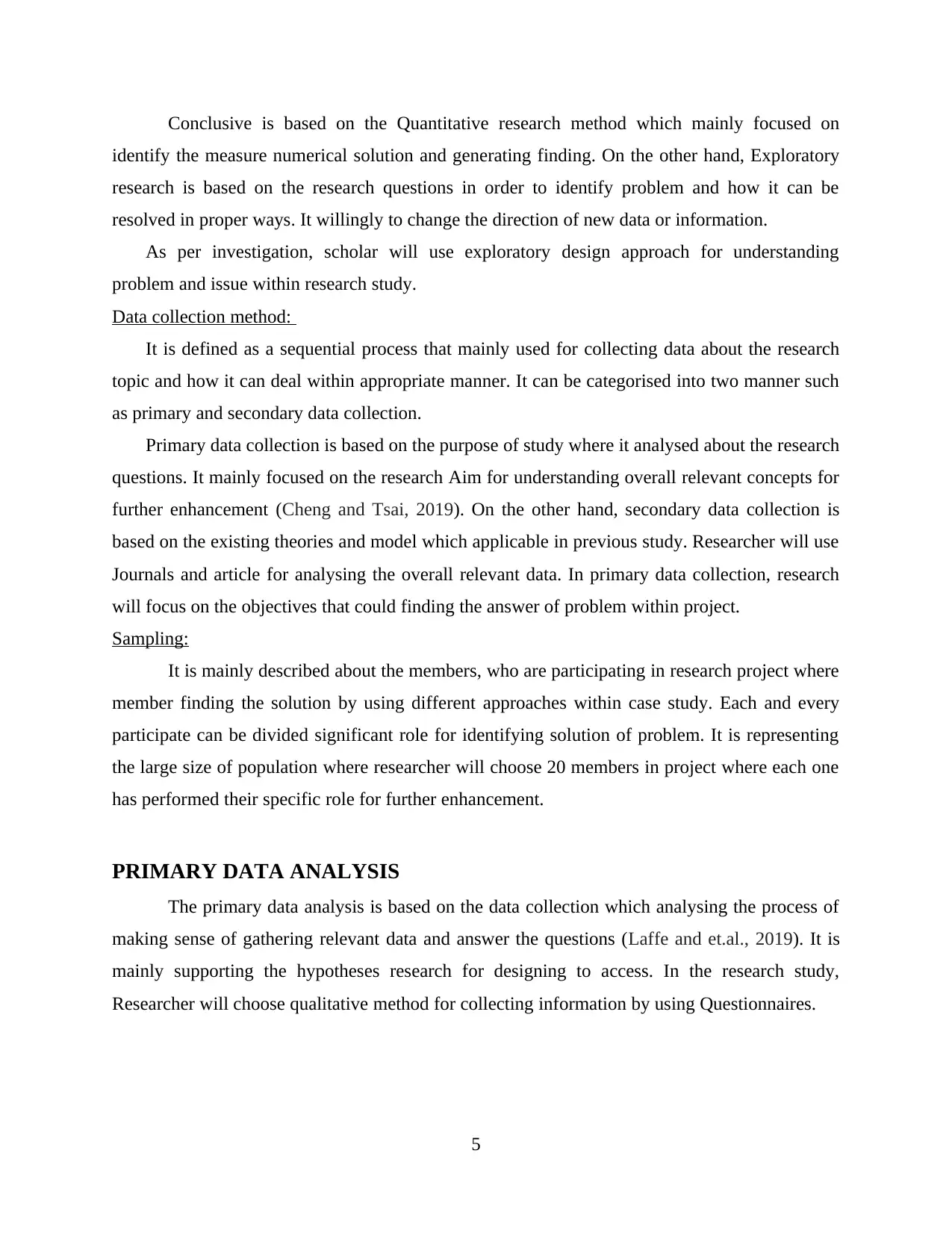
Conclusive is based on the Quantitative research method which mainly focused on
identify the measure numerical solution and generating finding. On the other hand, Exploratory
research is based on the research questions in order to identify problem and how it can be
resolved in proper ways. It willingly to change the direction of new data or information.
As per investigation, scholar will use exploratory design approach for understanding
problem and issue within research study.
Data collection method:
It is defined as a sequential process that mainly used for collecting data about the research
topic and how it can deal within appropriate manner. It can be categorised into two manner such
as primary and secondary data collection.
Primary data collection is based on the purpose of study where it analysed about the research
questions. It mainly focused on the research Aim for understanding overall relevant concepts for
further enhancement (Cheng and Tsai, 2019). On the other hand, secondary data collection is
based on the existing theories and model which applicable in previous study. Researcher will use
Journals and article for analysing the overall relevant data. In primary data collection, research
will focus on the objectives that could finding the answer of problem within project.
Sampling:
It is mainly described about the members, who are participating in research project where
member finding the solution by using different approaches within case study. Each and every
participate can be divided significant role for identifying solution of problem. It is representing
the large size of population where researcher will choose 20 members in project where each one
has performed their specific role for further enhancement.
PRIMARY DATA ANALYSIS
The primary data analysis is based on the data collection which analysing the process of
making sense of gathering relevant data and answer the questions (Laffe and et.al., 2019). It is
mainly supporting the hypotheses research for designing to access. In the research study,
Researcher will choose qualitative method for collecting information by using Questionnaires.
5
identify the measure numerical solution and generating finding. On the other hand, Exploratory
research is based on the research questions in order to identify problem and how it can be
resolved in proper ways. It willingly to change the direction of new data or information.
As per investigation, scholar will use exploratory design approach for understanding
problem and issue within research study.
Data collection method:
It is defined as a sequential process that mainly used for collecting data about the research
topic and how it can deal within appropriate manner. It can be categorised into two manner such
as primary and secondary data collection.
Primary data collection is based on the purpose of study where it analysed about the research
questions. It mainly focused on the research Aim for understanding overall relevant concepts for
further enhancement (Cheng and Tsai, 2019). On the other hand, secondary data collection is
based on the existing theories and model which applicable in previous study. Researcher will use
Journals and article for analysing the overall relevant data. In primary data collection, research
will focus on the objectives that could finding the answer of problem within project.
Sampling:
It is mainly described about the members, who are participating in research project where
member finding the solution by using different approaches within case study. Each and every
participate can be divided significant role for identifying solution of problem. It is representing
the large size of population where researcher will choose 20 members in project where each one
has performed their specific role for further enhancement.
PRIMARY DATA ANALYSIS
The primary data analysis is based on the data collection which analysing the process of
making sense of gathering relevant data and answer the questions (Laffe and et.al., 2019). It is
mainly supporting the hypotheses research for designing to access. In the research study,
Researcher will choose qualitative method for collecting information by using Questionnaires.
5

Theme:1 Virtual learning environment increase the performance and efficiency of student.
Q1. Do you think that Virtual learning environment increase the performance and efficiency of
student?
Frequency Respondent
Strongly Agree 13
Agree 10
Strongly disagree 5
disagree 2
Total 20
Table :1
Figure 1
Data Interpretation:
In above data analysis, it has summarised about the virtual learning environment that
increases performance and efficiency of student because it helps for developing interest towards
learning and attracted the digital conceptual framework. In this way, student always participate
within Virtual learning events for improving their own skill and knowledge. As per analysis, it
6
Q1. Do you think that Virtual learning environment increase the performance and efficiency of
student?
Frequency Respondent
Strongly Agree 13
Agree 10
Strongly disagree 5
disagree 2
Total 20
Table :1
Figure 1
Data Interpretation:
In above data analysis, it has summarised about the virtual learning environment that
increases performance and efficiency of student because it helps for developing interest towards
learning and attracted the digital conceptual framework. In this way, student always participate
within Virtual learning events for improving their own skill and knowledge. As per analysis, it
6
⊘ This is a preview!⊘
Do you want full access?
Subscribe today to unlock all pages.

Trusted by 1+ million students worldwide
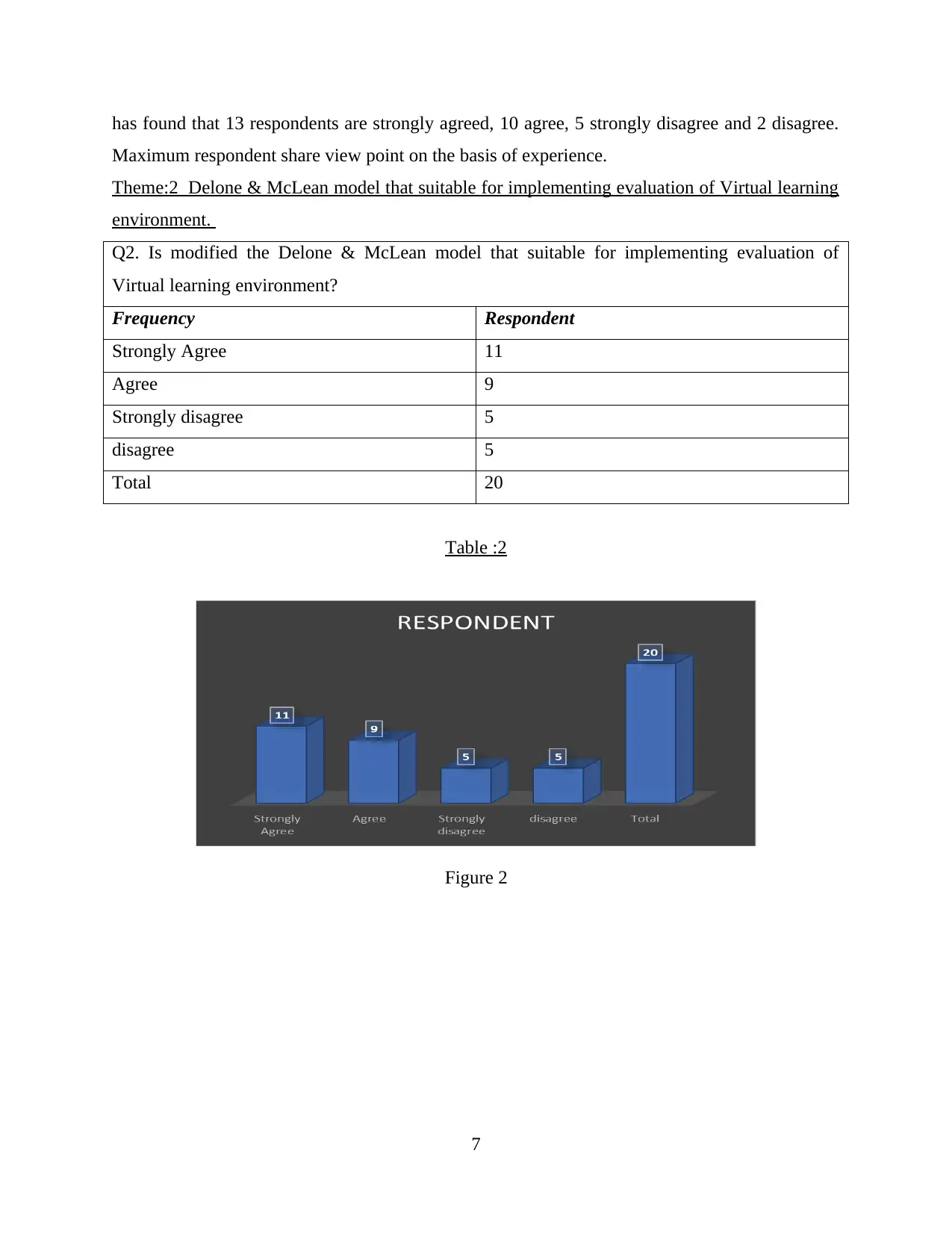
has found that 13 respondents are strongly agreed, 10 agree, 5 strongly disagree and 2 disagree.
Maximum respondent share view point on the basis of experience.
Theme:2 Delone & McLean model that suitable for implementing evaluation of Virtual learning
environment.
Q2. Is modified the Delone & McLean model that suitable for implementing evaluation of
Virtual learning environment?
Frequency Respondent
Strongly Agree 11
Agree 9
Strongly disagree 5
disagree 5
Total 20
Table :2
Figure 2
7
Maximum respondent share view point on the basis of experience.
Theme:2 Delone & McLean model that suitable for implementing evaluation of Virtual learning
environment.
Q2. Is modified the Delone & McLean model that suitable for implementing evaluation of
Virtual learning environment?
Frequency Respondent
Strongly Agree 11
Agree 9
Strongly disagree 5
disagree 5
Total 20
Table :2
Figure 2
7
Paraphrase This Document
Need a fresh take? Get an instant paraphrase of this document with our AI Paraphraser
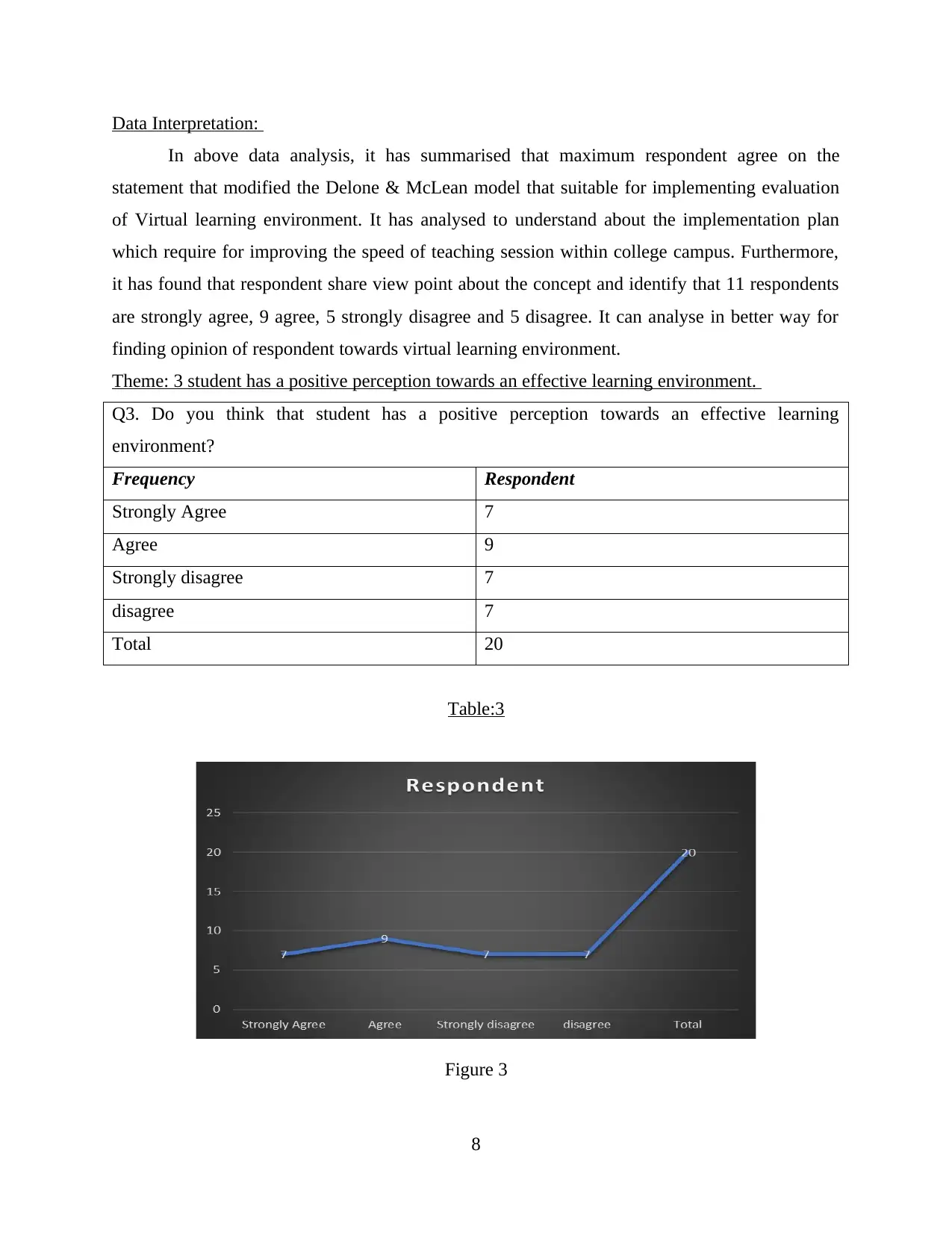
Data Interpretation:
In above data analysis, it has summarised that maximum respondent agree on the
statement that modified the Delone & McLean model that suitable for implementing evaluation
of Virtual learning environment. It has analysed to understand about the implementation plan
which require for improving the speed of teaching session within college campus. Furthermore,
it has found that respondent share view point about the concept and identify that 11 respondents
are strongly agree, 9 agree, 5 strongly disagree and 5 disagree. It can analyse in better way for
finding opinion of respondent towards virtual learning environment.
Theme: 3 student has a positive perception towards an effective learning environment.
Q3. Do you think that student has a positive perception towards an effective learning
environment?
Frequency Respondent
Strongly Agree 7
Agree 9
Strongly disagree 7
disagree 7
Total 20
Table:3
Figure 3
8
In above data analysis, it has summarised that maximum respondent agree on the
statement that modified the Delone & McLean model that suitable for implementing evaluation
of Virtual learning environment. It has analysed to understand about the implementation plan
which require for improving the speed of teaching session within college campus. Furthermore,
it has found that respondent share view point about the concept and identify that 11 respondents
are strongly agree, 9 agree, 5 strongly disagree and 5 disagree. It can analyse in better way for
finding opinion of respondent towards virtual learning environment.
Theme: 3 student has a positive perception towards an effective learning environment.
Q3. Do you think that student has a positive perception towards an effective learning
environment?
Frequency Respondent
Strongly Agree 7
Agree 9
Strongly disagree 7
disagree 7
Total 20
Table:3
Figure 3
8
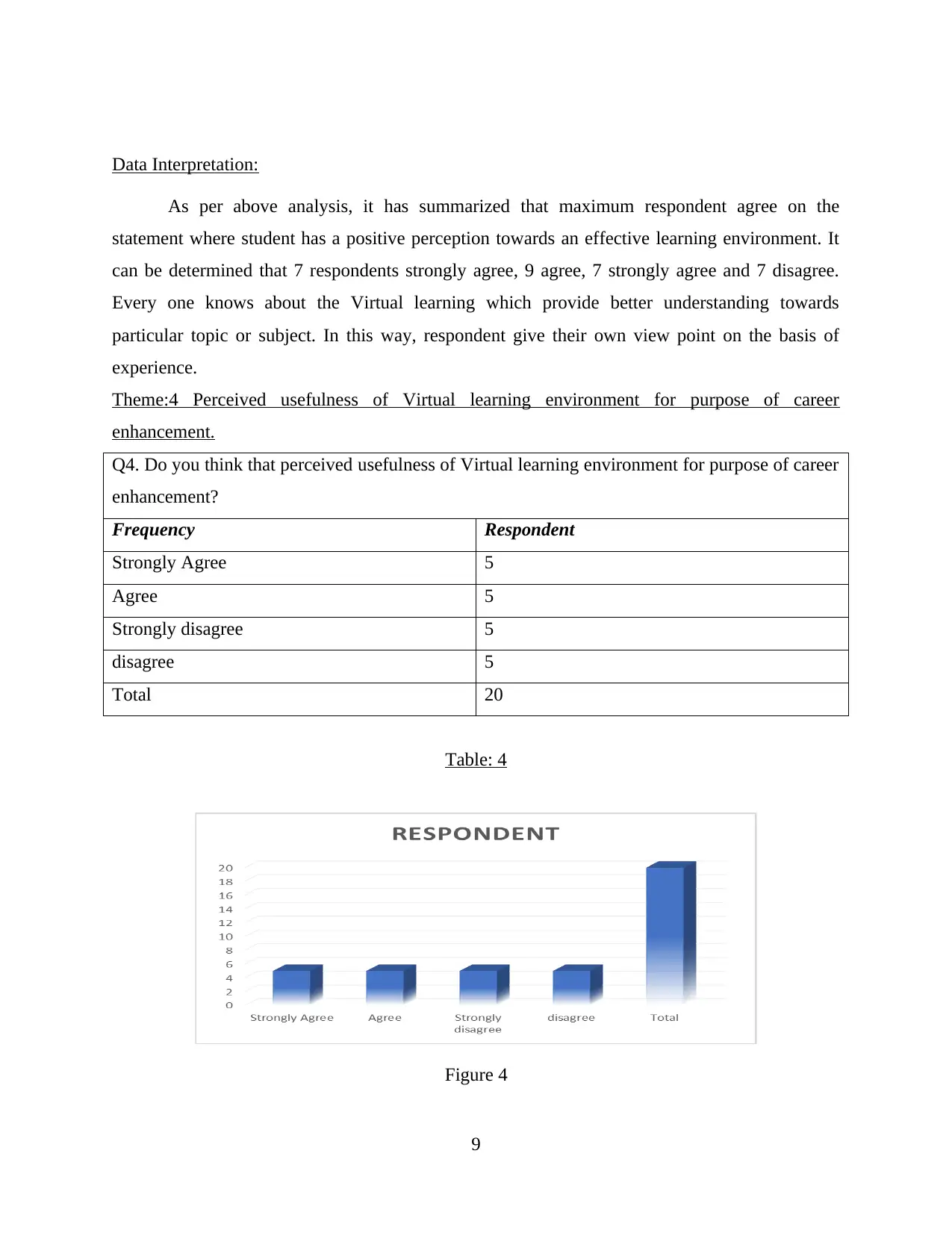
Data Interpretation:
As per above analysis, it has summarized that maximum respondent agree on the
statement where student has a positive perception towards an effective learning environment. It
can be determined that 7 respondents strongly agree, 9 agree, 7 strongly agree and 7 disagree.
Every one knows about the Virtual learning which provide better understanding towards
particular topic or subject. In this way, respondent give their own view point on the basis of
experience.
Theme:4 Perceived usefulness of Virtual learning environment for purpose of career
enhancement.
Q4. Do you think that perceived usefulness of Virtual learning environment for purpose of career
enhancement?
Frequency Respondent
Strongly Agree 5
Agree 5
Strongly disagree 5
disagree 5
Total 20
Table: 4
Figure 4
9
As per above analysis, it has summarized that maximum respondent agree on the
statement where student has a positive perception towards an effective learning environment. It
can be determined that 7 respondents strongly agree, 9 agree, 7 strongly agree and 7 disagree.
Every one knows about the Virtual learning which provide better understanding towards
particular topic or subject. In this way, respondent give their own view point on the basis of
experience.
Theme:4 Perceived usefulness of Virtual learning environment for purpose of career
enhancement.
Q4. Do you think that perceived usefulness of Virtual learning environment for purpose of career
enhancement?
Frequency Respondent
Strongly Agree 5
Agree 5
Strongly disagree 5
disagree 5
Total 20
Table: 4
Figure 4
9
⊘ This is a preview!⊘
Do you want full access?
Subscribe today to unlock all pages.

Trusted by 1+ million students worldwide

Data Interpretation:
In above data analysis, it has summarised that maximum respondents agree and disagree
on the statement that perceived usefulness of Virtual learning environment for purpose of career
enhancement. It has analysed to understand about the student build self-knowledge and skill
which always helping for career development. it helps for improving the performance and
efficiency in teaching session within college campus. Furthermore, it has found that 5
respondents are strongly agree, 5 agree, 5 strongly disagree and 5 disagree. It can analyse in
better way for finding opinion of respondent towards virtual learning environment.
SECONDARY DATA ANALYSIS
It is a type of process for collecting and gathering data related the research project. It
mainly involves the researcher by using information for own purpose (Bulut, 2019). Researcher
will use the secondary analysis which attempt to answer new research question which examine
the perception of previous study. Researcher will analyse the secondary data through journals,
articles and books.
Virtual learning environment impacts on the student learning experience because many
institutes used the concept for boost the education level and also implementing innovative idea
for teaching. In this way, student will easily build their own interest towards learning. VLE
typically replicate traditional teaching process because of large number of distributions occurs
through online channel which providing better discussion (Pietarinen and et.al., 2019). The
potentialities of web will change life style of student. When people use network technologies to
develop Virtual learning environment. In fact, institution enable the Virtual learning that consists
of various elements which give many option to find answer and solution. In context of
classroom, learning interaction is becoming complex so as require to use virtual learning
environment that enable to change experience of student where they easily interact with large
number of information of data.
CONCLUSION
From Above study, it concluded that Virtual learning environment is conceptual terms that
applicable within education institutes where student has improved their own abilities and
capabilities. In order to achieve personal development in career enhancement. It has summarised
10
In above data analysis, it has summarised that maximum respondents agree and disagree
on the statement that perceived usefulness of Virtual learning environment for purpose of career
enhancement. It has analysed to understand about the student build self-knowledge and skill
which always helping for career development. it helps for improving the performance and
efficiency in teaching session within college campus. Furthermore, it has found that 5
respondents are strongly agree, 5 agree, 5 strongly disagree and 5 disagree. It can analyse in
better way for finding opinion of respondent towards virtual learning environment.
SECONDARY DATA ANALYSIS
It is a type of process for collecting and gathering data related the research project. It
mainly involves the researcher by using information for own purpose (Bulut, 2019). Researcher
will use the secondary analysis which attempt to answer new research question which examine
the perception of previous study. Researcher will analyse the secondary data through journals,
articles and books.
Virtual learning environment impacts on the student learning experience because many
institutes used the concept for boost the education level and also implementing innovative idea
for teaching. In this way, student will easily build their own interest towards learning. VLE
typically replicate traditional teaching process because of large number of distributions occurs
through online channel which providing better discussion (Pietarinen and et.al., 2019). The
potentialities of web will change life style of student. When people use network technologies to
develop Virtual learning environment. In fact, institution enable the Virtual learning that consists
of various elements which give many option to find answer and solution. In context of
classroom, learning interaction is becoming complex so as require to use virtual learning
environment that enable to change experience of student where they easily interact with large
number of information of data.
CONCLUSION
From Above study, it concluded that Virtual learning environment is conceptual terms that
applicable within education institutes where student has improved their own abilities and
capabilities. In order to achieve personal development in career enhancement. It has summarised
10
Paraphrase This Document
Need a fresh take? Get an instant paraphrase of this document with our AI Paraphraser
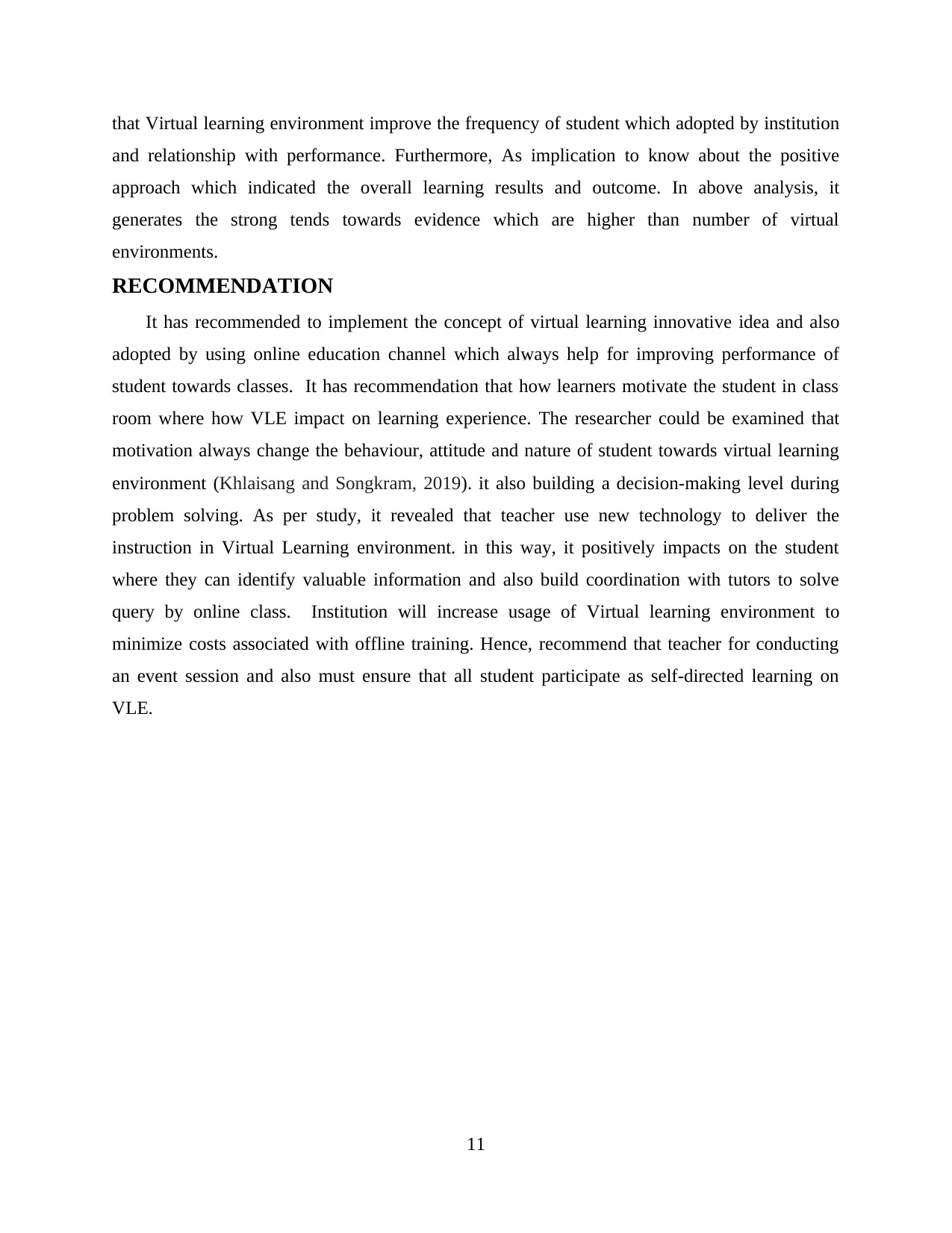
that Virtual learning environment improve the frequency of student which adopted by institution
and relationship with performance. Furthermore, As implication to know about the positive
approach which indicated the overall learning results and outcome. In above analysis, it
generates the strong tends towards evidence which are higher than number of virtual
environments.
RECOMMENDATION
It has recommended to implement the concept of virtual learning innovative idea and also
adopted by using online education channel which always help for improving performance of
student towards classes. It has recommendation that how learners motivate the student in class
room where how VLE impact on learning experience. The researcher could be examined that
motivation always change the behaviour, attitude and nature of student towards virtual learning
environment (Khlaisang and Songkram, 2019). it also building a decision-making level during
problem solving. As per study, it revealed that teacher use new technology to deliver the
instruction in Virtual Learning environment. in this way, it positively impacts on the student
where they can identify valuable information and also build coordination with tutors to solve
query by online class. Institution will increase usage of Virtual learning environment to
minimize costs associated with offline training. Hence, recommend that teacher for conducting
an event session and also must ensure that all student participate as self-directed learning on
VLE.
11
and relationship with performance. Furthermore, As implication to know about the positive
approach which indicated the overall learning results and outcome. In above analysis, it
generates the strong tends towards evidence which are higher than number of virtual
environments.
RECOMMENDATION
It has recommended to implement the concept of virtual learning innovative idea and also
adopted by using online education channel which always help for improving performance of
student towards classes. It has recommendation that how learners motivate the student in class
room where how VLE impact on learning experience. The researcher could be examined that
motivation always change the behaviour, attitude and nature of student towards virtual learning
environment (Khlaisang and Songkram, 2019). it also building a decision-making level during
problem solving. As per study, it revealed that teacher use new technology to deliver the
instruction in Virtual Learning environment. in this way, it positively impacts on the student
where they can identify valuable information and also build coordination with tutors to solve
query by online class. Institution will increase usage of Virtual learning environment to
minimize costs associated with offline training. Hence, recommend that teacher for conducting
an event session and also must ensure that all student participate as self-directed learning on
VLE.
11
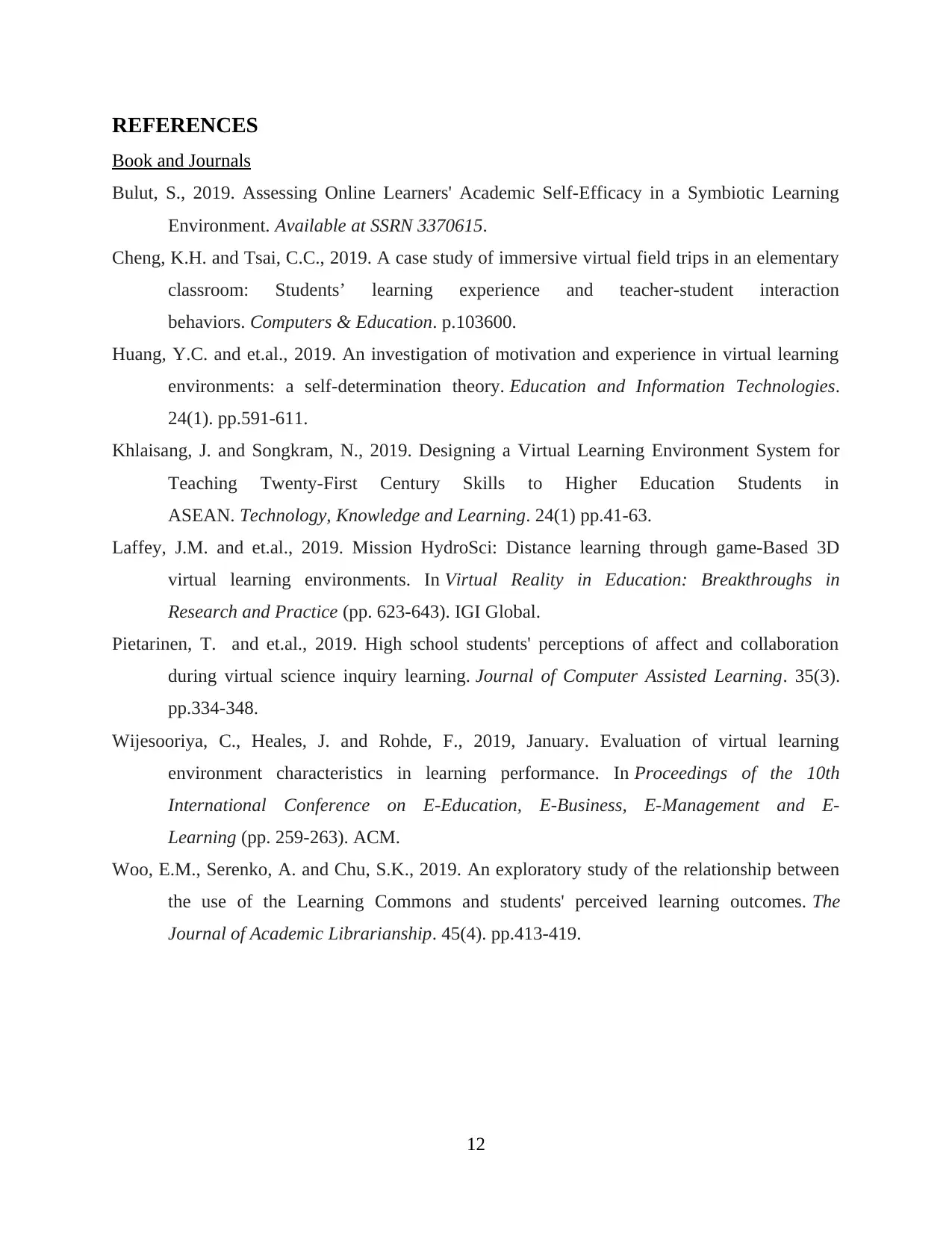
REFERENCES
Book and Journals
Bulut, S., 2019. Assessing Online Learners' Academic Self-Efficacy in a Symbiotic Learning
Environment. Available at SSRN 3370615.
Cheng, K.H. and Tsai, C.C., 2019. A case study of immersive virtual field trips in an elementary
classroom: Students’ learning experience and teacher-student interaction
behaviors. Computers & Education. p.103600.
Huang, Y.C. and et.al., 2019. An investigation of motivation and experience in virtual learning
environments: a self-determination theory. Education and Information Technologies.
24(1). pp.591-611.
Khlaisang, J. and Songkram, N., 2019. Designing a Virtual Learning Environment System for
Teaching Twenty-First Century Skills to Higher Education Students in
ASEAN. Technology, Knowledge and Learning. 24(1) pp.41-63.
Laffey, J.M. and et.al., 2019. Mission HydroSci: Distance learning through game-Based 3D
virtual learning environments. In Virtual Reality in Education: Breakthroughs in
Research and Practice (pp. 623-643). IGI Global.
Pietarinen, T. and et.al., 2019. High school students' perceptions of affect and collaboration
during virtual science inquiry learning. Journal of Computer Assisted Learning. 35(3).
pp.334-348.
Wijesooriya, C., Heales, J. and Rohde, F., 2019, January. Evaluation of virtual learning
environment characteristics in learning performance. In Proceedings of the 10th
International Conference on E-Education, E-Business, E-Management and E-
Learning (pp. 259-263). ACM.
Woo, E.M., Serenko, A. and Chu, S.K., 2019. An exploratory study of the relationship between
the use of the Learning Commons and students' perceived learning outcomes. The
Journal of Academic Librarianship. 45(4). pp.413-419.
12
Book and Journals
Bulut, S., 2019. Assessing Online Learners' Academic Self-Efficacy in a Symbiotic Learning
Environment. Available at SSRN 3370615.
Cheng, K.H. and Tsai, C.C., 2019. A case study of immersive virtual field trips in an elementary
classroom: Students’ learning experience and teacher-student interaction
behaviors. Computers & Education. p.103600.
Huang, Y.C. and et.al., 2019. An investigation of motivation and experience in virtual learning
environments: a self-determination theory. Education and Information Technologies.
24(1). pp.591-611.
Khlaisang, J. and Songkram, N., 2019. Designing a Virtual Learning Environment System for
Teaching Twenty-First Century Skills to Higher Education Students in
ASEAN. Technology, Knowledge and Learning. 24(1) pp.41-63.
Laffey, J.M. and et.al., 2019. Mission HydroSci: Distance learning through game-Based 3D
virtual learning environments. In Virtual Reality in Education: Breakthroughs in
Research and Practice (pp. 623-643). IGI Global.
Pietarinen, T. and et.al., 2019. High school students' perceptions of affect and collaboration
during virtual science inquiry learning. Journal of Computer Assisted Learning. 35(3).
pp.334-348.
Wijesooriya, C., Heales, J. and Rohde, F., 2019, January. Evaluation of virtual learning
environment characteristics in learning performance. In Proceedings of the 10th
International Conference on E-Education, E-Business, E-Management and E-
Learning (pp. 259-263). ACM.
Woo, E.M., Serenko, A. and Chu, S.K., 2019. An exploratory study of the relationship between
the use of the Learning Commons and students' perceived learning outcomes. The
Journal of Academic Librarianship. 45(4). pp.413-419.
12
⊘ This is a preview!⊘
Do you want full access?
Subscribe today to unlock all pages.

Trusted by 1+ million students worldwide
1 out of 13
Related Documents
Your All-in-One AI-Powered Toolkit for Academic Success.
+13062052269
info@desklib.com
Available 24*7 on WhatsApp / Email
![[object Object]](/_next/static/media/star-bottom.7253800d.svg)
Unlock your academic potential
Copyright © 2020–2025 A2Z Services. All Rights Reserved. Developed and managed by ZUCOL.




